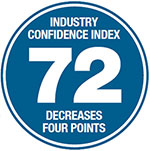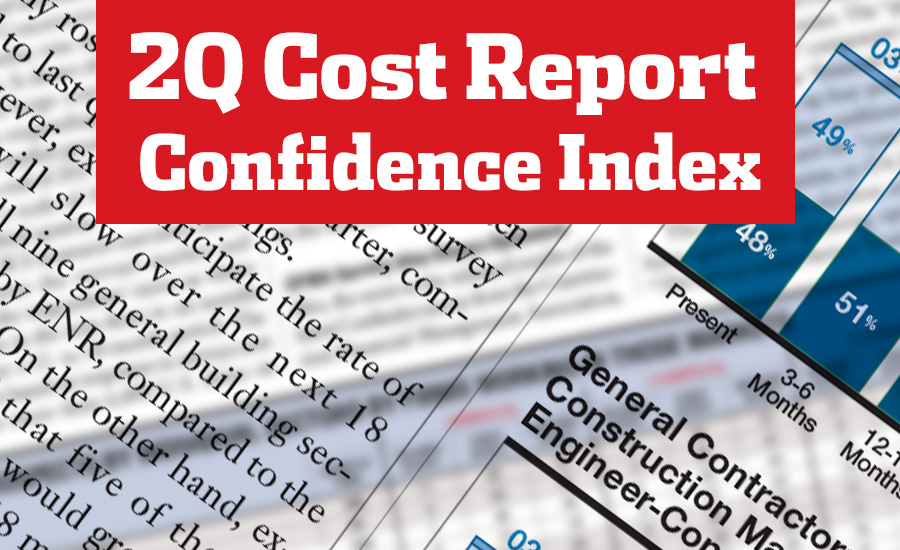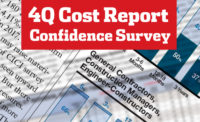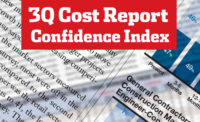The construction market remains strong, but construction firms that were excited about the pro-business agenda of President Trump immediately after his election in November are now moderating their long-term outlook.
 Most executives believe the market will continue to grow for another year, but many believe the boom will begin to level off in 2019 unless the Trump administration shows more progress on its pro-growth initiatives.
Most executives believe the market will continue to grow for another year, but many believe the boom will begin to level off in 2019 unless the Trump administration shows more progress on its pro-growth initiatives.
The new caution can be seen in the results of the ENR Construction Industry Confidence Index survey. The CICI fell in the second quarter after rising sharply for two straight quarters. Of the 232 executives of large construction and design firms responding to the survey, most believe market growth will continue at least through the middle of 2018. But beyond that, the execs are less optimistic. The CICI index fell four points to 72 on a scale of 100 from the first quarter of 2017.
The CICI measures executive sentiment about the current market and reflects the respondents’ views on where it will be in the next three to six months and over a 12- to 18-month period. The index is based on responses to surveys sent out from May 26 through June 26 to more than 6,000 U.S. firms on ENR’s lists of leading general contractors, subcontractors and design firms.
View the full ENR 2017 2Q Cost Report PDF
CFMA Survey Sees Cause for Concern
The soon-to-be-released results of the latest Confindex survey from the Construction Financial Management Association, Princeton, N.J., similarly show that executives are growing more wary of what 2018 and beyond will bring to the construction market.
CFMA each quarter polls 200 CFOs from general and civil contractors and subs. The CFMA Confindex is based on four separate financial and market components, each rated on a scale of one to 200. A rating of 100 indicates a stable market; higher ratings show market growth or conditions that should foster growth.
“The overall Confindex fell from 130 in the first quarter to 123 in the current quarter,” says Stuart Binstock, CEO of CFMA. Two of the four components of the Confindex also fell dramatically in the first quarter, he notes.
The “general business conditions” component plunged 12 points, to 124, and the “year-ahead outlook” also fell 12 points, to 119, Binstock says. The Confindex “financial conditions” component fell a more modest two points, to 123, and the “current market conditions” component declined three points, to 126, Binstock notes.
Much of this decline in confidence comes from the growing realization that much of the Trump agenda is at risk from Congress. “Much of the bounce in the Confindex was from the industry’s reaction to November’s election: that Trump’s agenda could help the industry,” says Anirban Basu, CEO of economic consultant Sage Policy Group Inc., Baltimore.
“The real star of the agenda was the $1-trillion infrastructure stimulus proposal,” Basu says. But after five months in office, Trump is no closer to fulfilling his promises on infrastructure than he was in January. “Many in the industry believe there won’t be an infrastructure package until 2018, if at all,” he adds.
Another concern among the CFOs answering the CFMA survey is what financial conditions will be like in 2018. “In our fourth quarter survey, 46% of CFOs believed profits would rise next year,” says Binstock.
He further notes that in the first quarter, 40% believed profits would be up in the year ahead, but in the current quarter, only 30% believe profits will be up next year.
“One of the major problems is staff shortages are putting pressure on wages. Wage increases go directly to the bottom line,” Binstock says, adding that CFMA members hoped that a rising market would raise revenue and increase margins, offsetting added labor costs. “Now, our members are not so sure.”
Going-Out-of-Business Sales
When applying the CICI formula to individual market sectors, confidence in ten of the 15 markets measured by the survey actually rose in the second quarter, compared to last quarter’s ratings.
However, execs anticipate the rate of growth will slow over the next 18 months in all nine general building sectors measured by ENR, compared to the current market. On the other hand, executives believed that five of the six non-building sectors would grow more quickly over the next 18 months. Only hazardous waste sagged.
One major economic trend is having an impact on the ENR CICI survey. The growing trend among the public favoring online buying is having a severe impact on the retail market. The retail sector is now the lowest rated of all 15 sectors measured by the survey, with a CICI rating of 43. This rating is down 13 points in just the past six months.
The trend toward online buying has resulted in the lack of demand for new or refurbished stores. Basu says, “There are studies that estimate that there will be as many as 8,600 store closings this year. That is more than in 2008, when we had the financial meltdown.”
Overall, construction executives believe that the market will continue to grow through the end of 2018, but wonder whether the market’s day of reckoning will come in 2019. “Six months ago,
people were not worried about the future. Now they are,” Basu says.






Post a comment to this article
Report Abusive Comment